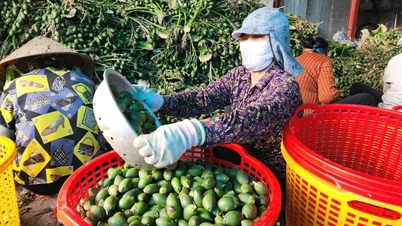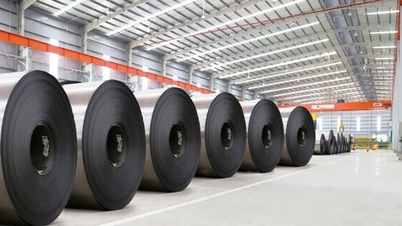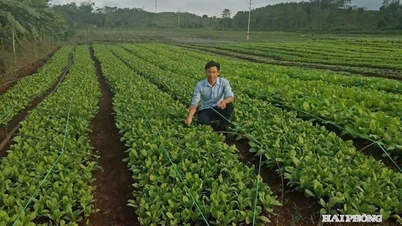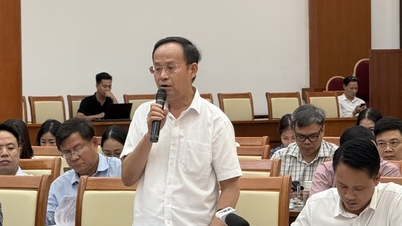The Ministry of Industry and Trade 's announcement of the FTA Index for the first time in April 2024 opened a new approach in assessing the effectiveness of implementing free trade agreements (FTAs) in Vietnam. If previously, research and statistics were mainly focused at the central level, then with the FTA Index, for the first time, the level of FTA utilization and implementation is "illuminated" down to each locality - where businesses are directly supported, policies are implemented and integration commitments are realized.
The FTA Index 2024 results show a colorful picture. The top 10 leading localities include Ca Mau, Thanh Hoa, Binh Duong, Khanh Hoa, Tra Vinh , Long An, Ha Giang, Bac Lieu, Ninh Binh and Dien Bien, with scores ranging from 31 to nearly 35. However, the national average score is only 26.2/100 and the lowest locality is only 14.49 points, reflecting a significant difference.

Sharing at the seminar “Results of the first year of the FTA Index – Issues raised”, organized by Industry and Trade Magazine on October 3, Associate Professor, Dr. Dao Ngoc Tien, Vice Rector of Foreign Trade University, said that when surveying and analyzing data to build the FTA Index, the drafting committee found that both local authorities and businesses have not considered FTA as a long-term strategy.
Notably, businesses, especially small and medium enterprises, have not proactively approached opportunities from FTAs. Some localities have issued documents on FTAs, but how to implement them is up to the businesses, leading to businesses not even knowing about the existence of FTAs.
From another perspective, Mr. Ngo Chung Khanh, Deputy Director of the Multilateral Trade Policy Department (Ministry of Industry and Trade) pointed out that almost no enterprises have set up a separate legal department or hired consultants specializing in FTAs. Human resources deployed in many provinces and cities are still thin, while local support policies are uneven, some places do well, but many places just stop at formalities. In reality, most enterprises still focus on traditional markets, while new markets have not been properly exploited.
Mr. Khanh cited that the EU imports more than 1,000 billion USD worth of goods each year, but the proportion of Vietnamese goods accounts for less than 2%. Meanwhile, EVFTA has entered its 5th year, and in just two years, many Vietnamese products will enjoy a 0% tax rate. "If businesses do not quickly grasp the opportunity, we will miss the golden opportunity to break through exports," Mr. Khanh warned.
The bright spot is that after the FTA Index was announced in March 2025, many provinces and cities changed their approach, developed specific plans, and increased substantial support for businesses.
However, the key factor still lies in the internal transformation of the enterprise with a proactive mindset of integration, market diversification, improving product quality, complying with international standards and building a sustainable brand.
"In the context of global economic fluctuations, we cannot depend on one market. Businesses need to urgently shift to the EU, UK, Canada, and Mexico to turn opportunities from FTAs into long-term competitive advantages," Mr. Khanh said.
Representing the business sector, Dr. Nguyen Van Than, Chairman of the Vietnam Association of Small and Medium Enterprises (VINASME), frankly admitted that most small and medium enterprises are not fully aware of the impact of FTAs. Many enterprises are still struggling in the role of processing, lacking a strategy to become a professional manufacturer and trader to reach demanding but high-value markets.
Mr. Than highly appreciated the formation of the FTA Index, considering it an important national index because it involves both local authorities and the business community. However, for this index to be truly effective, according to him, it is necessary to include the FTA Index in the group of criteria for local ranking. "If that is the case, the provincial leaders will focus resources immediately, because when the index becomes an official 'measure', the pressure for improvement will be greater," he emphasized.
According to experts, in order for the FTA Index to fully develop its value, it is necessary to expand its scope and improve its assessment methods. Associate Professor, Dr. Dao Ngoc Tien proposed adjusting the proportion of indicators, increasing the role of sustainable development factors and non-tariff incentives, which is a long-term trend. In addition, the scope of the survey should be expanded to include cooperatives and collective economies because these are components that contribute to exports but have not been measured.
On the side of the Ministry of Industry and Trade, Mr. Ngo Chung Khanh said that the Ministry is coordinating with ministries, branches and localities to build a set of updated and more practical assessment questions. At the same time, provinces will be given specific instructions to improve results not only to "increase scores" but more importantly to effectively support businesses.
In addition, according to experts, in the context of many global fluctuations, from reciprocal tax policies to protectionist trends, Vietnamese enterprises are forced to diversify their markets. Along with support policies from the state, enterprises themselves must proactively transform and invest to meet international standards, especially in demanding markets. This is the only way to achieve sustainable development goals.
Source: https://baotintuc.vn/kinh-te/doanh-nghiep-nho-va-vua-chua-chu-dong-tiep-can-co-hoi-tu-fta-20251003165309041.htm



![[Photo] Students of Binh Minh Primary School enjoy the full moon festival, receiving the joys of childhood](https://vphoto.vietnam.vn/thumb/1200x675/vietnam/resource/IMAGE/2025/10/3/8cf8abef22fe4471be400a818912cb85)
![[Photo] Prime Minister Pham Minh Chinh chairs meeting to deploy overcoming consequences of storm No. 10](https://vphoto.vietnam.vn/thumb/1200x675/vietnam/resource/IMAGE/2025/10/3/544f420dcc844463898fcbef46247d16)



![[Infographic] What are the growth targets of Dong Nai province in the first 9 months of 2025?](https://vphoto.vietnam.vn/thumb/402x226/vietnam/resource/IMAGE/2025/10/3/45f9330556eb4c6a88b098a6624d7e5b)
































































































Comment (0)